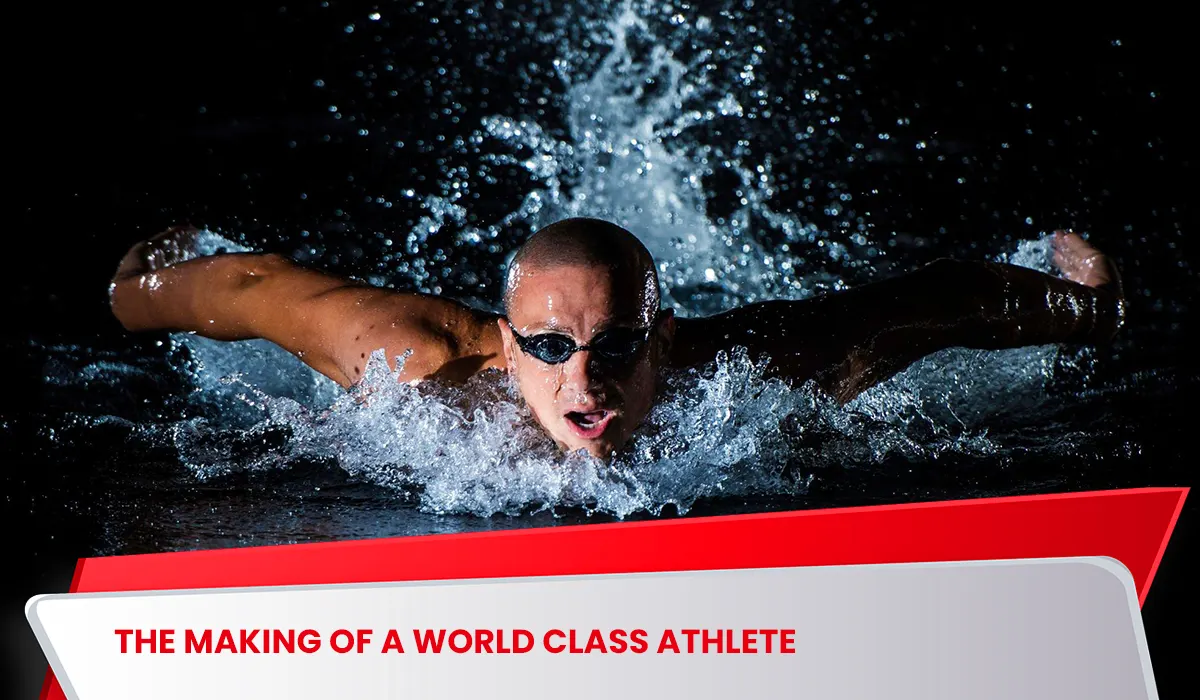The most widely accepted rule in sports is that it takes 10,000 hours of practice to excel, master, and emerge ahead of the competition. At least, this is what a 1993 paper titled The Role of Deliberate Practice in the Acquisition of Expert Performance by Anders Ericsson, a Professor at the University of Colorado, claims. While repetition can fine-tune and sharpen ability and technique to remarkable levels, there are many more factors to improve and master in order to emerge ahead of the game and compete and sustain oneself at world standards.
Throughout the realm of sport, there are athletes who stand out from their colleagues due to exceptional ability. These extraordinary powers are much beyond the ordinary. For example, consider Roger Federer’s ability to brutally dominate international tennis for more than a decade before reinventing his game and winning three Grand Slam titles in his mid-30s. Or Virat Kohli’s application, effort, and drive to consistently raising the performance threshold and delivering 2,818 runs across formats in 2017. (11 Hundreds including 3 Doubles & 10 Fifties at an average of over 70). Or Jahangir Khan’s discipline, hard work, fitness, and ambition, which enabled him to be unbeaten in World Squash for nearly 5 years and win 555 consecutive matches. Or Usain Bolt’s dominance of world athletics with unwavering focus and tremendous self-belief, which earned him a record 9 Olympic Gold medals. Or Lionel Messi’s ability to understand the game, his patience, and his ability to score under pressure frequently, making him one of the greatest footballers in history.
After speaking with athletes from various disciplines, age groups, geographies, genders, and generations, three crucial factors emerge that differentiate outstanding and spectacular performance:
THE MAKING OF A WORLD CLASS ATHLETE

INGREDIENTS
A world-class athlete’s formula contains eight elements (in no particular order of relevance or priority). These are the enabling base line factors that lead to success, and they include:
1: Work Ethic – the commitment and discipline to put in thousands of hours of structured practice and repetitive game exercises replicating match conditions helps an athlete develop the correct mental orientation to deal with match situations. This defines the athlete’s capacity to focus and produce winning moments.
2: Financial Assistance – Sports training is an expensive endeavor. Moving on becomes extremely tough unless the athlete has the financial means to support his athletic interest. Early financial support from family and community develops the interest into a passion.
3: Support Systems – The athlete’s family allows him to pursue his interest in sports by managing the commonplace, such as travel, food, scheduling, academic priorities, and contests. The support of family members, a kind word, a shove to push forward, and cheering go a long way toward propelling the athlete forward. Most essential, the athlete must be managed and monitored from a distance by the athlete’s family. Otherwise, boundaries become blurred, causing friction and problems.
4: Physicality & Body Type – A slim body, hand-eye coordination, nimbleness, flexibility, and quick reflexes are the first characteristics of someone who has a natural affinity for sports. Other early indicators include a want to be outside, a desire to break a sweat, a drive to compete, and a willingness to stretch beyond our limits.
5: Handle Stress and Pressure – In the early years of a developing athlete’s life, the pressure to achieve academically, participate in school activities, and explore an interest in athletics can be difficult for most people. Furthermore, the excessive or subtle pressure exerted by friends, family, and the community to produce results in athletics becomes too much for most people to take. Those who deal with it advance in competitive sport, discovering it to be a life skill and a vital distinction.
6: Manage Workload & Burnout – Establishing a balance between fitness, training, and rest early in an athlete’s career is crucial. Athletes that spend too much time exercising do not have enough time to heal physically and emotionally. Furthermore, too enthusiastic family members continually discussing sports in their spare time causes even more harm. Rest, other recreational activities, and downtime are all important for long-term success.
7: Blessings & Luck – To put it simply, one must be blessed. In sports, chance has a significant impact. Despite having practiced over extended periods of time for a specific goal, the luck of the draw, a bad referee judgment, a broken string at a vital point, playing against a fan favorite, or simply having a terrible day might mean the difference between winning and losing. Of course, the athlete gradually learns to deal with the unexpected. However, in order to cross the finish line as intended, the athlete’s stars must be precisely aligned, as well as the mother’s blessings. That is a sport.
8: Exposure & Opportunity – The opportunity to compete in different competitions, different geographies, and against different athletes in varied match play situations provides tremendous exposure for the athlete to put himself to the test. In such trying circumstances, he learns himself and grows for the better. In other cases, the shock causes the athlete to reflect and strive harder to improve.
DIMENSIONS
Five dimensions (in no particular order of importance or priority) that must be developed in order to compete and succeed at the top level of performance in any sport include:
1: Fitness, Sleep, and Nutrition – What you eat, how much you hydrate, how you train, and how much you rest your mind and body fundamentally define the results you want to achieve as an athlete. If you are well fed and rested before entering the playing arena, you will be bursting with energy and the drive to provide your finest performance.
2: Attitude & Mental Conditioning – An athlete’s attitude is the sum of his or her long-term goals, individual ownership, process adherence, desire for challenge, and risk-taking abilities. Inadequate attitude results in poor planning, suboptimal execution, and disappointing results. Some of the methods used to prepare, perform, and produce results include positive thinking, game and outcome visualization, scenario preparation, mental and physical drills to deal with competitive pressure, and breathing exercises.
3: Core Strength, Mobility, and Agility – It’s unfortunate that most athletes overlook this key feature. Core strength keeps you safe from injury, protects your central nervous system, enhances body balance, and allows you to run longer. Mobility is a measure of how smoothly and efficiently we move, and it is essential for preventing injuries. Agility aids the body in orchestrating integrated, coordinated, and well-balanced motions and has a direct impact on speed and reflexes. All three are essential in sports.
4: Have Fun – If you aren’t bursting with energy and enthusiasm every time you step onto the field, it’s time to move on. Athletes who are dedicated to their sport cannot imagine their lives without it. It’s their way of life. Coaches have an important role in ensuring that time spent on the field is fascinating, demanding, stimulating, competitive, and enjoyable.
5: Technique & Skill – Technique refers to the ability to accomplish a physical task, whilst skill refers to the ability to perform a task in a gaming context. Both of these crucial qualities are necessary for an athlete to flourish in his chosen discipline and are critical to success. It takes hours and hours of effort, focus, tenacity, and steely conviction to master them. This is the blood, sweat, and tears that each athlete expends in order to come out on top. Eventually, the athlete will be able to efficiently and repeatedly perform a drill with extremely high levels of accuracy. A good coach is crucial in this situation.
ATTRIBUTES

Six intrinsic characteristics (in no particular order of importance or priority) that assist build the context, particularly in the early years, but continue to make the difference between remarkable and spectacular performance and include:
1: Self Belief – Confidence in one’s ability to function under difficult conditions while achieving desired results. It is founded on positive thinking, faith in one’s own hard work, work ethic, and training. This takes time to develop, but producing outcomes and performance accelerates the process.
Committed athletes have a single objective in mind, a strong desire to succeed, and a readiness to sacrifice. Everything else takes a back seat to their enthusiasm. What doesn’t fit into their narrow perspective is eventually irrelevant.
3: Absolute Truth – Athletes are brutally honest with themselves, even to the point of being critical of themselves. They anticipate honest feedback, even if it is hurtful, from those in their immediate circle of influence. They reflect, confront the unpleasant truth, and then take corrective action to go closer to their ultimate goal. And this becomes a continuous process.
4: Life Balance – Balancing numerous priorities is a great art that athletes master early on. Time management, outcome focus, and concentration have all become important life skills.
5: Sheer Hard Work – Putting in the blood, sweat, and tears to grasp the numerous aspects of sport teaches the athlete patience, frustration, tenacity, and the magnitude of effort required to achieve success.
6: Passion & Drive – Athletes’ motivation and resilience to achieve highlight the big picture of their lives and help them translate potential into uofumobilityhub.com results. Passion and drive outline the athlete’s solitary aim and show the dedication and desire to succeed.
